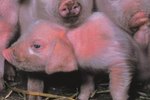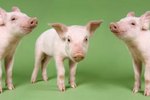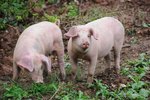Identifying a Gloucestershire Old Spots pig doesn't take much in the way of swine expertise -- it's the white animal with black spots. This heritage breed descends from two now-extinct types of British pig, the Berkshire and the Gloucestershire. Although the Gloucestershire Old Spots is relatively rare, the American Livestock Breeds Conservancy reports that it is a favorite of the British royal family, who prefers meat from this breed.
Appearance
In order to be registered with the Gloucestershire Old Spots of America breed association, a pig must be white with defined black spots. Blue, or slate gray, spotting is unacceptable. The ears are a distinctive feature, as they drop forward towards the pig's nose more than other breeds. The skin should not appear coarse or wrinkled, and its coat must be silky, not curly, according to the breed standard.
Temperament
The breeds' basically docile temperament makes it a good choice for novice or amateur pig farmers. It's a smart, affable animal, more interested in finding food than in causing mischief around the small farm. Because it's a rare breed and has an even temperament, the Old Spots is also a candidate for owners who wish to compete in pig shows.
Reproduction
Old Spots sows produce large litters and plenty of milk to feed the piglets. Sows should possess at least 14 teats. The sows remain fertile and producing considerably past the age of many other pig breeds. Old Spots also make good crosses on other breeds of pigs, adding hardiness and the breeds' other qualities. The British Gloucestershire Old Spots Pig Breeders' Club, the oldest purebred pig registry in the world, reports that if an Old Spots is crossed with a white pig, offspring are white.
Foraging
Among the most economical of pig breeds to raise, the Old Spots is renowned for its foraging abilities. If you have pasture available, let your Old Spots eat and root in it. These animals also do an excellent job of cleaning up leftover apples and other fruits from orchards -- they were known in Great Britain as "the orchard pig." These self-sufficient porcines can withstand cold and hot weather extremes, as well as rain and snow.
References
- American Livestock Breeds Conservancy: Gloucestershire Old Spot Pig
- Oklahoma State University: Gloucestershire Old Spots
- Gloucestershire Old Spots of America, Inc.: The Gloucestershire Old Spots Pig
- Gloucestershire Old Spots Pig Breeders' Club: Breed Advantages
- Gloucestershire Old Spots Pig Breeders' Club: Breed Standard
Writer Bio
Jane Meggitt has been a writer for more than 20 years. In addition to reporting for a major newspaper chain, she has been published in "Horse News," "Suburban Classic," "Hoof Beats," "Equine Journal" and other publications. She has a Bachelor of Arts in English from New York University and an Associate of Arts from the American Academy of Dramatics Arts, New York City.





